A Report on the Analysis of US Environmental Public Policy and Goals
VerifiedAdded on 2021/05/31
|9
|2106
|23
Report
AI Summary
This report provides a comprehensive analysis of environmental public policy in the United States. It begins with a brief history of environmental protection, highlighting key legislation like the National Environmental Protection Act (NEPA) and the establishment of the Environmental Protection Agency (EPA). The report examines current policies, including the Air Pollution Act, Clean Air Act, and the Clean Power Plan, focusing on their goals such as reducing carbon emissions and promoting sustainable development. It also discusses the stakeholders involved, including the state, legislature, and judiciary, and outlines an evaluation plan to assess the policy's impact. Furthermore, the report analyzes the US withdrawal from the Paris Agreement, its implications, and the differing stances of various stakeholders. The analysis is supported by references to scholarly articles and reports, offering a detailed overview of the complexities and challenges of US environmental policy.

Running head: PUBLIC POLICY
Public Policy
Name of the Student
Name of the University
Author Note
Public Policy
Name of the Student
Name of the University
Author Note
Paraphrase This Document
Need a fresh take? Get an instant paraphrase of this document with our AI Paraphraser
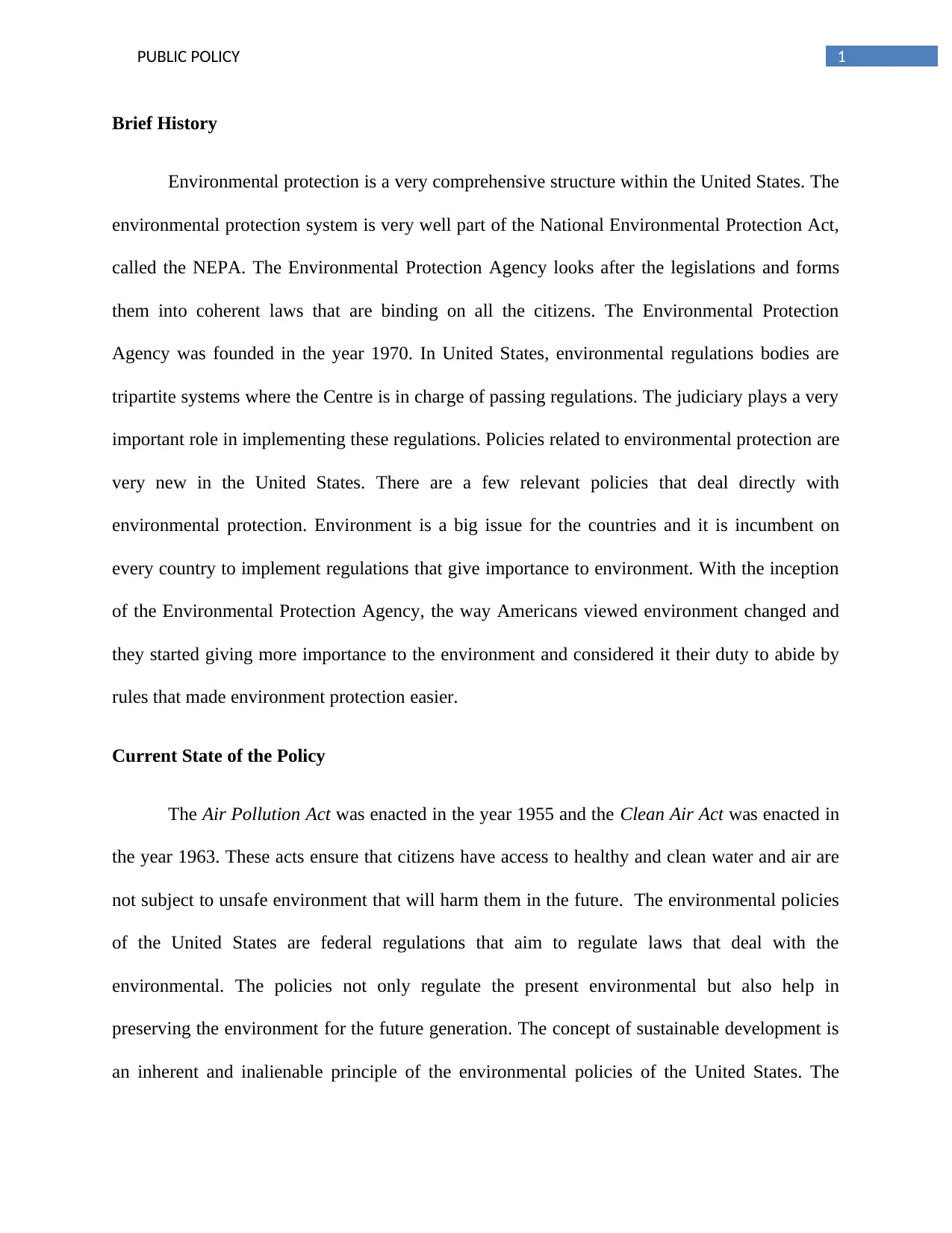
1PUBLIC POLICY
Brief History
Environmental protection is a very comprehensive structure within the United States. The
environmental protection system is very well part of the National Environmental Protection Act,
called the NEPA. The Environmental Protection Agency looks after the legislations and forms
them into coherent laws that are binding on all the citizens. The Environmental Protection
Agency was founded in the year 1970. In United States, environmental regulations bodies are
tripartite systems where the Centre is in charge of passing regulations. The judiciary plays a very
important role in implementing these regulations. Policies related to environmental protection are
very new in the United States. There are a few relevant policies that deal directly with
environmental protection. Environment is a big issue for the countries and it is incumbent on
every country to implement regulations that give importance to environment. With the inception
of the Environmental Protection Agency, the way Americans viewed environment changed and
they started giving more importance to the environment and considered it their duty to abide by
rules that made environment protection easier.
Current State of the Policy
The Air Pollution Act was enacted in the year 1955 and the Clean Air Act was enacted in
the year 1963. These acts ensure that citizens have access to healthy and clean water and air are
not subject to unsafe environment that will harm them in the future. The environmental policies
of the United States are federal regulations that aim to regulate laws that deal with the
environmental. The policies not only regulate the present environmental but also help in
preserving the environment for the future generation. The concept of sustainable development is
an inherent and inalienable principle of the environmental policies of the United States. The
Brief History
Environmental protection is a very comprehensive structure within the United States. The
environmental protection system is very well part of the National Environmental Protection Act,
called the NEPA. The Environmental Protection Agency looks after the legislations and forms
them into coherent laws that are binding on all the citizens. The Environmental Protection
Agency was founded in the year 1970. In United States, environmental regulations bodies are
tripartite systems where the Centre is in charge of passing regulations. The judiciary plays a very
important role in implementing these regulations. Policies related to environmental protection are
very new in the United States. There are a few relevant policies that deal directly with
environmental protection. Environment is a big issue for the countries and it is incumbent on
every country to implement regulations that give importance to environment. With the inception
of the Environmental Protection Agency, the way Americans viewed environment changed and
they started giving more importance to the environment and considered it their duty to abide by
rules that made environment protection easier.
Current State of the Policy
The Air Pollution Act was enacted in the year 1955 and the Clean Air Act was enacted in
the year 1963. These acts ensure that citizens have access to healthy and clean water and air are
not subject to unsafe environment that will harm them in the future. The environmental policies
of the United States are federal regulations that aim to regulate laws that deal with the
environmental. The policies not only regulate the present environmental but also help in
preserving the environment for the future generation. The concept of sustainable development is
an inherent and inalienable principle of the environmental policies of the United States. The
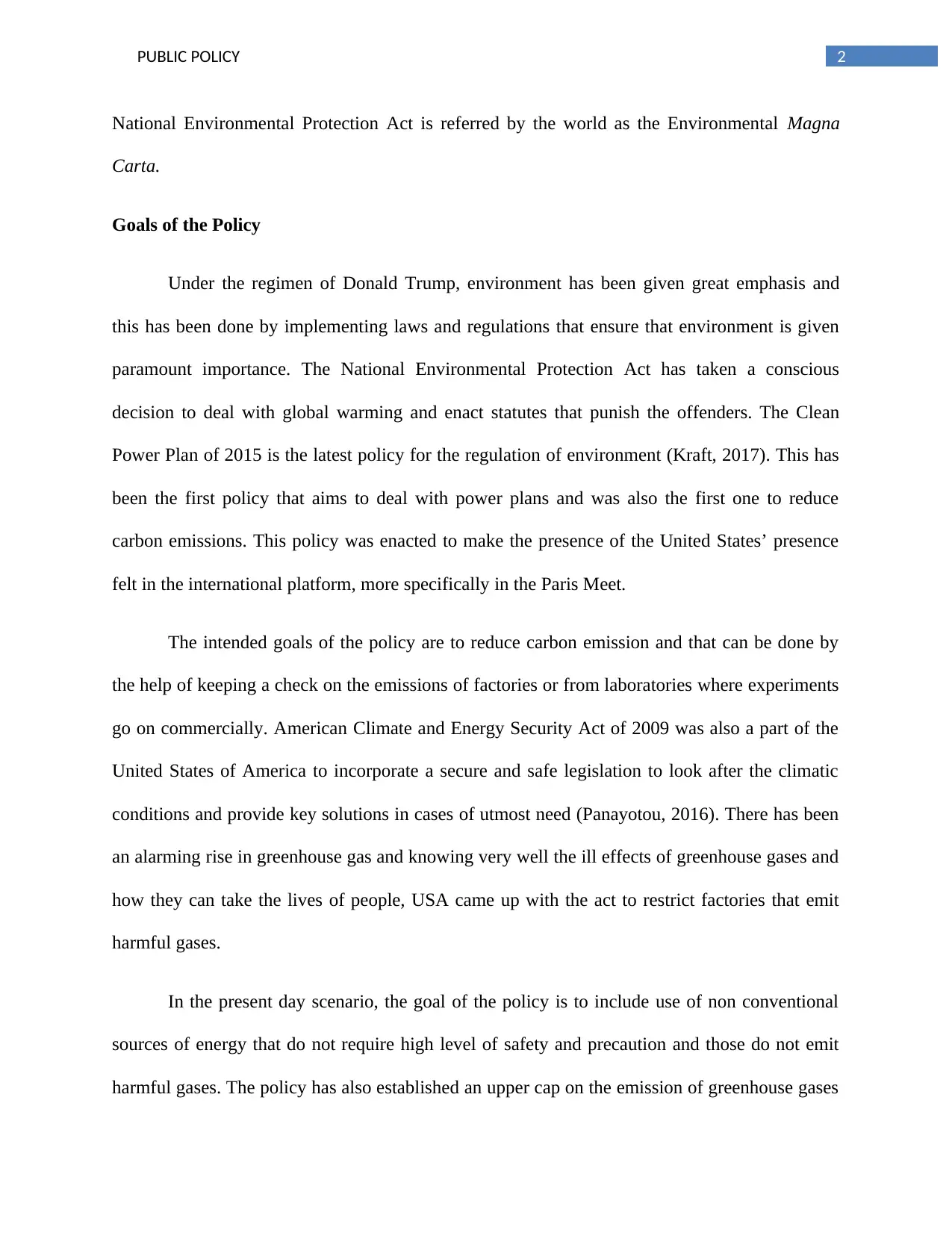
2PUBLIC POLICY
National Environmental Protection Act is referred by the world as the Environmental Magna
Carta.
Goals of the Policy
Under the regimen of Donald Trump, environment has been given great emphasis and
this has been done by implementing laws and regulations that ensure that environment is given
paramount importance. The National Environmental Protection Act has taken a conscious
decision to deal with global warming and enact statutes that punish the offenders. The Clean
Power Plan of 2015 is the latest policy for the regulation of environment (Kraft, 2017). This has
been the first policy that aims to deal with power plans and was also the first one to reduce
carbon emissions. This policy was enacted to make the presence of the United States’ presence
felt in the international platform, more specifically in the Paris Meet.
The intended goals of the policy are to reduce carbon emission and that can be done by
the help of keeping a check on the emissions of factories or from laboratories where experiments
go on commercially. American Climate and Energy Security Act of 2009 was also a part of the
United States of America to incorporate a secure and safe legislation to look after the climatic
conditions and provide key solutions in cases of utmost need (Panayotou, 2016). There has been
an alarming rise in greenhouse gas and knowing very well the ill effects of greenhouse gases and
how they can take the lives of people, USA came up with the act to restrict factories that emit
harmful gases.
In the present day scenario, the goal of the policy is to include use of non conventional
sources of energy that do not require high level of safety and precaution and those do not emit
harmful gases. The policy has also established an upper cap on the emission of greenhouse gases
National Environmental Protection Act is referred by the world as the Environmental Magna
Carta.
Goals of the Policy
Under the regimen of Donald Trump, environment has been given great emphasis and
this has been done by implementing laws and regulations that ensure that environment is given
paramount importance. The National Environmental Protection Act has taken a conscious
decision to deal with global warming and enact statutes that punish the offenders. The Clean
Power Plan of 2015 is the latest policy for the regulation of environment (Kraft, 2017). This has
been the first policy that aims to deal with power plans and was also the first one to reduce
carbon emissions. This policy was enacted to make the presence of the United States’ presence
felt in the international platform, more specifically in the Paris Meet.
The intended goals of the policy are to reduce carbon emission and that can be done by
the help of keeping a check on the emissions of factories or from laboratories where experiments
go on commercially. American Climate and Energy Security Act of 2009 was also a part of the
United States of America to incorporate a secure and safe legislation to look after the climatic
conditions and provide key solutions in cases of utmost need (Panayotou, 2016). There has been
an alarming rise in greenhouse gas and knowing very well the ill effects of greenhouse gases and
how they can take the lives of people, USA came up with the act to restrict factories that emit
harmful gases.
In the present day scenario, the goal of the policy is to include use of non conventional
sources of energy that do not require high level of safety and precaution and those do not emit
harmful gases. The policy has also established an upper cap on the emission of greenhouse gases
⊘ This is a preview!⊘
Do you want full access?
Subscribe today to unlock all pages.

Trusted by 1+ million students worldwide
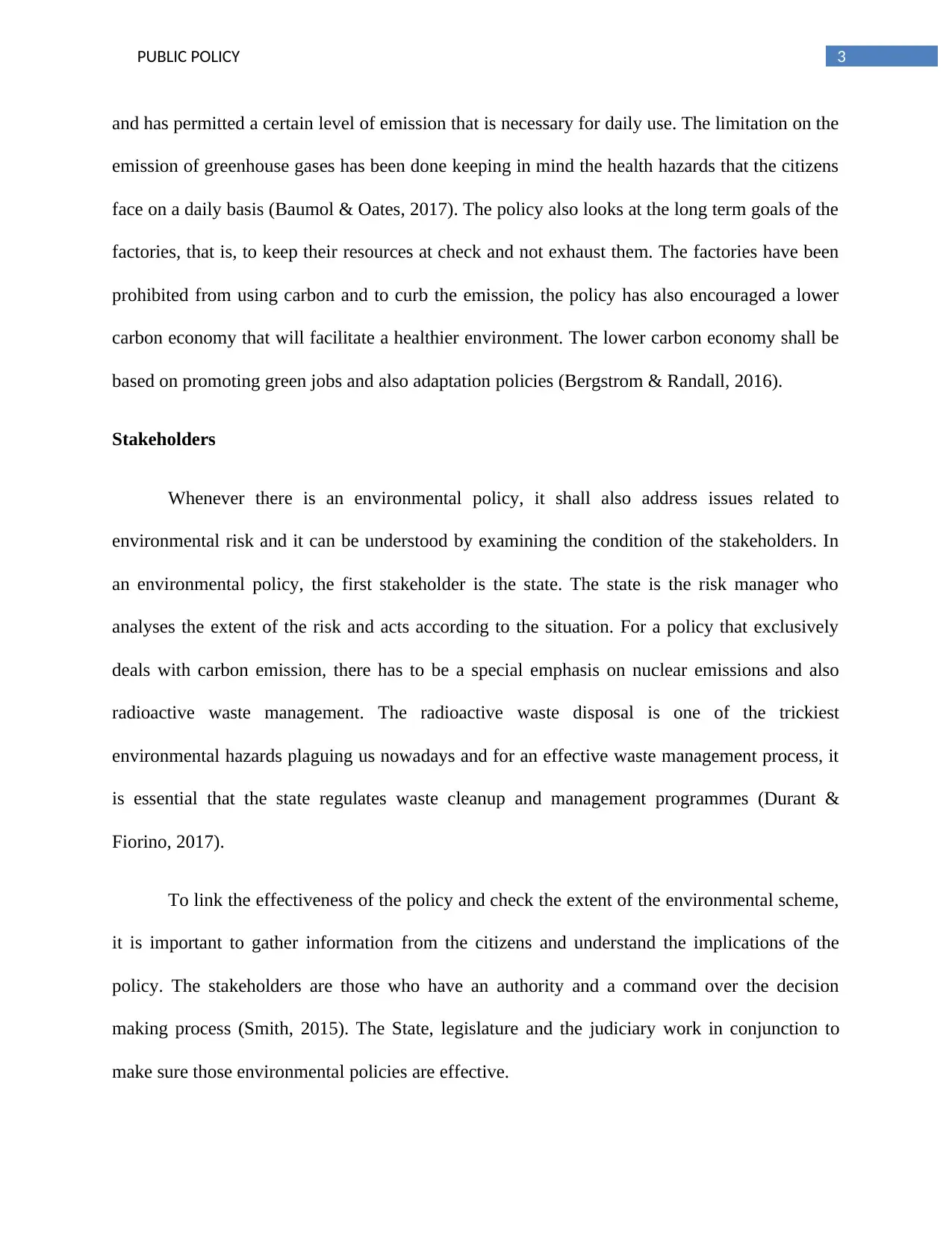
3PUBLIC POLICY
and has permitted a certain level of emission that is necessary for daily use. The limitation on the
emission of greenhouse gases has been done keeping in mind the health hazards that the citizens
face on a daily basis (Baumol & Oates, 2017). The policy also looks at the long term goals of the
factories, that is, to keep their resources at check and not exhaust them. The factories have been
prohibited from using carbon and to curb the emission, the policy has also encouraged a lower
carbon economy that will facilitate a healthier environment. The lower carbon economy shall be
based on promoting green jobs and also adaptation policies (Bergstrom & Randall, 2016).
Stakeholders
Whenever there is an environmental policy, it shall also address issues related to
environmental risk and it can be understood by examining the condition of the stakeholders. In
an environmental policy, the first stakeholder is the state. The state is the risk manager who
analyses the extent of the risk and acts according to the situation. For a policy that exclusively
deals with carbon emission, there has to be a special emphasis on nuclear emissions and also
radioactive waste management. The radioactive waste disposal is one of the trickiest
environmental hazards plaguing us nowadays and for an effective waste management process, it
is essential that the state regulates waste cleanup and management programmes (Durant &
Fiorino, 2017).
To link the effectiveness of the policy and check the extent of the environmental scheme,
it is important to gather information from the citizens and understand the implications of the
policy. The stakeholders are those who have an authority and a command over the decision
making process (Smith, 2015). The State, legislature and the judiciary work in conjunction to
make sure those environmental policies are effective.
and has permitted a certain level of emission that is necessary for daily use. The limitation on the
emission of greenhouse gases has been done keeping in mind the health hazards that the citizens
face on a daily basis (Baumol & Oates, 2017). The policy also looks at the long term goals of the
factories, that is, to keep their resources at check and not exhaust them. The factories have been
prohibited from using carbon and to curb the emission, the policy has also encouraged a lower
carbon economy that will facilitate a healthier environment. The lower carbon economy shall be
based on promoting green jobs and also adaptation policies (Bergstrom & Randall, 2016).
Stakeholders
Whenever there is an environmental policy, it shall also address issues related to
environmental risk and it can be understood by examining the condition of the stakeholders. In
an environmental policy, the first stakeholder is the state. The state is the risk manager who
analyses the extent of the risk and acts according to the situation. For a policy that exclusively
deals with carbon emission, there has to be a special emphasis on nuclear emissions and also
radioactive waste management. The radioactive waste disposal is one of the trickiest
environmental hazards plaguing us nowadays and for an effective waste management process, it
is essential that the state regulates waste cleanup and management programmes (Durant &
Fiorino, 2017).
To link the effectiveness of the policy and check the extent of the environmental scheme,
it is important to gather information from the citizens and understand the implications of the
policy. The stakeholders are those who have an authority and a command over the decision
making process (Smith, 2015). The State, legislature and the judiciary work in conjunction to
make sure those environmental policies are effective.
Paraphrase This Document
Need a fresh take? Get an instant paraphrase of this document with our AI Paraphraser
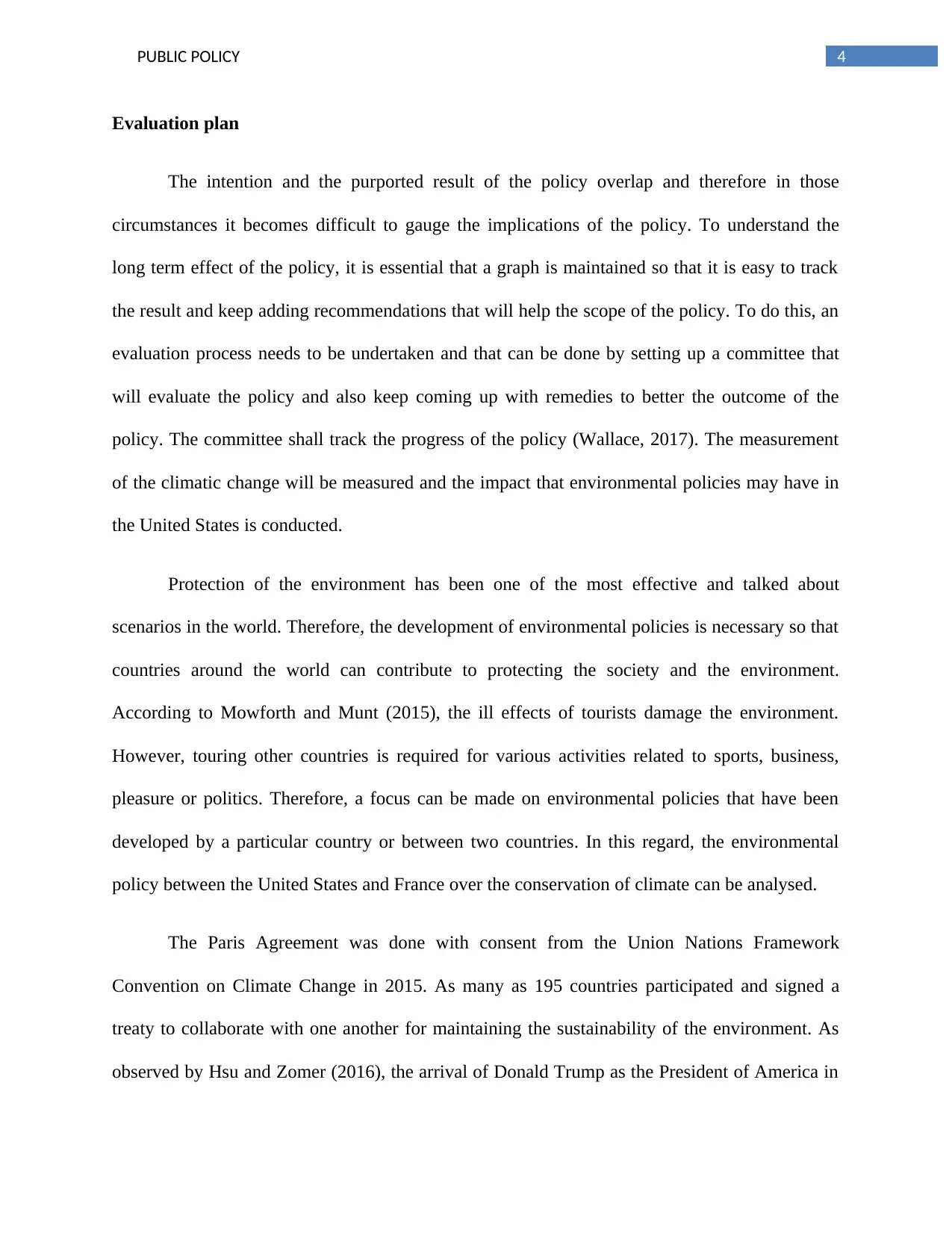
4PUBLIC POLICY
Evaluation plan
The intention and the purported result of the policy overlap and therefore in those
circumstances it becomes difficult to gauge the implications of the policy. To understand the
long term effect of the policy, it is essential that a graph is maintained so that it is easy to track
the result and keep adding recommendations that will help the scope of the policy. To do this, an
evaluation process needs to be undertaken and that can be done by setting up a committee that
will evaluate the policy and also keep coming up with remedies to better the outcome of the
policy. The committee shall track the progress of the policy (Wallace, 2017). The measurement
of the climatic change will be measured and the impact that environmental policies may have in
the United States is conducted.
Protection of the environment has been one of the most effective and talked about
scenarios in the world. Therefore, the development of environmental policies is necessary so that
countries around the world can contribute to protecting the society and the environment.
According to Mowforth and Munt (2015), the ill effects of tourists damage the environment.
However, touring other countries is required for various activities related to sports, business,
pleasure or politics. Therefore, a focus can be made on environmental policies that have been
developed by a particular country or between two countries. In this regard, the environmental
policy between the United States and France over the conservation of climate can be analysed.
The Paris Agreement was done with consent from the Union Nations Framework
Convention on Climate Change in 2015. As many as 195 countries participated and signed a
treaty to collaborate with one another for maintaining the sustainability of the environment. As
observed by Hsu and Zomer (2016), the arrival of Donald Trump as the President of America in
Evaluation plan
The intention and the purported result of the policy overlap and therefore in those
circumstances it becomes difficult to gauge the implications of the policy. To understand the
long term effect of the policy, it is essential that a graph is maintained so that it is easy to track
the result and keep adding recommendations that will help the scope of the policy. To do this, an
evaluation process needs to be undertaken and that can be done by setting up a committee that
will evaluate the policy and also keep coming up with remedies to better the outcome of the
policy. The committee shall track the progress of the policy (Wallace, 2017). The measurement
of the climatic change will be measured and the impact that environmental policies may have in
the United States is conducted.
Protection of the environment has been one of the most effective and talked about
scenarios in the world. Therefore, the development of environmental policies is necessary so that
countries around the world can contribute to protecting the society and the environment.
According to Mowforth and Munt (2015), the ill effects of tourists damage the environment.
However, touring other countries is required for various activities related to sports, business,
pleasure or politics. Therefore, a focus can be made on environmental policies that have been
developed by a particular country or between two countries. In this regard, the environmental
policy between the United States and France over the conservation of climate can be analysed.
The Paris Agreement was done with consent from the Union Nations Framework
Convention on Climate Change in 2015. As many as 195 countries participated and signed a
treaty to collaborate with one another for maintaining the sustainability of the environment. As
observed by Hsu and Zomer (2016), the arrival of Donald Trump as the President of America in
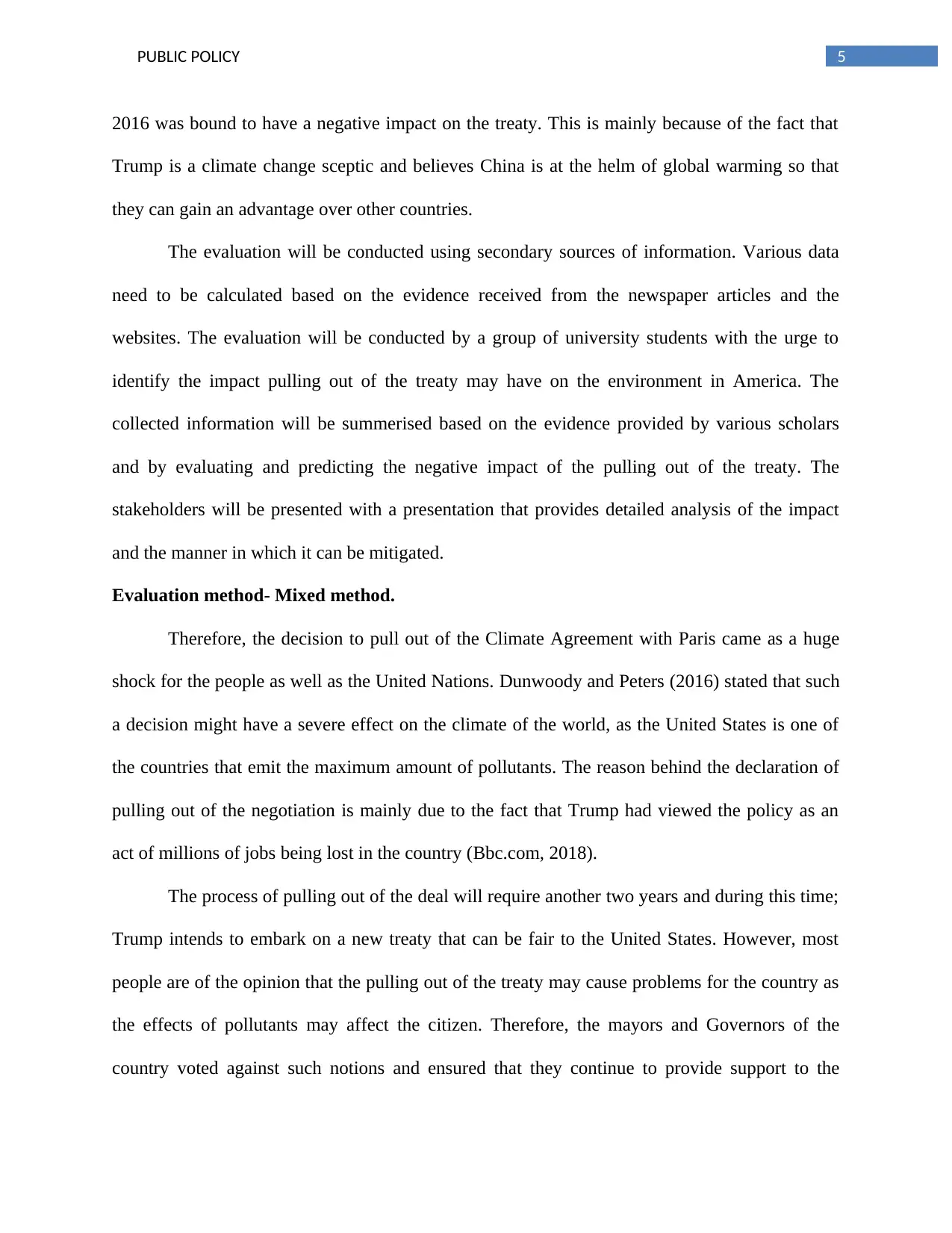
5PUBLIC POLICY
2016 was bound to have a negative impact on the treaty. This is mainly because of the fact that
Trump is a climate change sceptic and believes China is at the helm of global warming so that
they can gain an advantage over other countries.
The evaluation will be conducted using secondary sources of information. Various data
need to be calculated based on the evidence received from the newspaper articles and the
websites. The evaluation will be conducted by a group of university students with the urge to
identify the impact pulling out of the treaty may have on the environment in America. The
collected information will be summerised based on the evidence provided by various scholars
and by evaluating and predicting the negative impact of the pulling out of the treaty. The
stakeholders will be presented with a presentation that provides detailed analysis of the impact
and the manner in which it can be mitigated.
Evaluation method- Mixed method.
Therefore, the decision to pull out of the Climate Agreement with Paris came as a huge
shock for the people as well as the United Nations. Dunwoody and Peters (2016) stated that such
a decision might have a severe effect on the climate of the world, as the United States is one of
the countries that emit the maximum amount of pollutants. The reason behind the declaration of
pulling out of the negotiation is mainly due to the fact that Trump had viewed the policy as an
act of millions of jobs being lost in the country (Bbc.com, 2018).
The process of pulling out of the deal will require another two years and during this time;
Trump intends to embark on a new treaty that can be fair to the United States. However, most
people are of the opinion that the pulling out of the treaty may cause problems for the country as
the effects of pollutants may affect the citizen. Therefore, the mayors and Governors of the
country voted against such notions and ensured that they continue to provide support to the
2016 was bound to have a negative impact on the treaty. This is mainly because of the fact that
Trump is a climate change sceptic and believes China is at the helm of global warming so that
they can gain an advantage over other countries.
The evaluation will be conducted using secondary sources of information. Various data
need to be calculated based on the evidence received from the newspaper articles and the
websites. The evaluation will be conducted by a group of university students with the urge to
identify the impact pulling out of the treaty may have on the environment in America. The
collected information will be summerised based on the evidence provided by various scholars
and by evaluating and predicting the negative impact of the pulling out of the treaty. The
stakeholders will be presented with a presentation that provides detailed analysis of the impact
and the manner in which it can be mitigated.
Evaluation method- Mixed method.
Therefore, the decision to pull out of the Climate Agreement with Paris came as a huge
shock for the people as well as the United Nations. Dunwoody and Peters (2016) stated that such
a decision might have a severe effect on the climate of the world, as the United States is one of
the countries that emit the maximum amount of pollutants. The reason behind the declaration of
pulling out of the negotiation is mainly due to the fact that Trump had viewed the policy as an
act of millions of jobs being lost in the country (Bbc.com, 2018).
The process of pulling out of the deal will require another two years and during this time;
Trump intends to embark on a new treaty that can be fair to the United States. However, most
people are of the opinion that the pulling out of the treaty may cause problems for the country as
the effects of pollutants may affect the citizen. Therefore, the mayors and Governors of the
country voted against such notions and ensured that they continue to provide support to the
⊘ This is a preview!⊘
Do you want full access?
Subscribe today to unlock all pages.

Trusted by 1+ million students worldwide
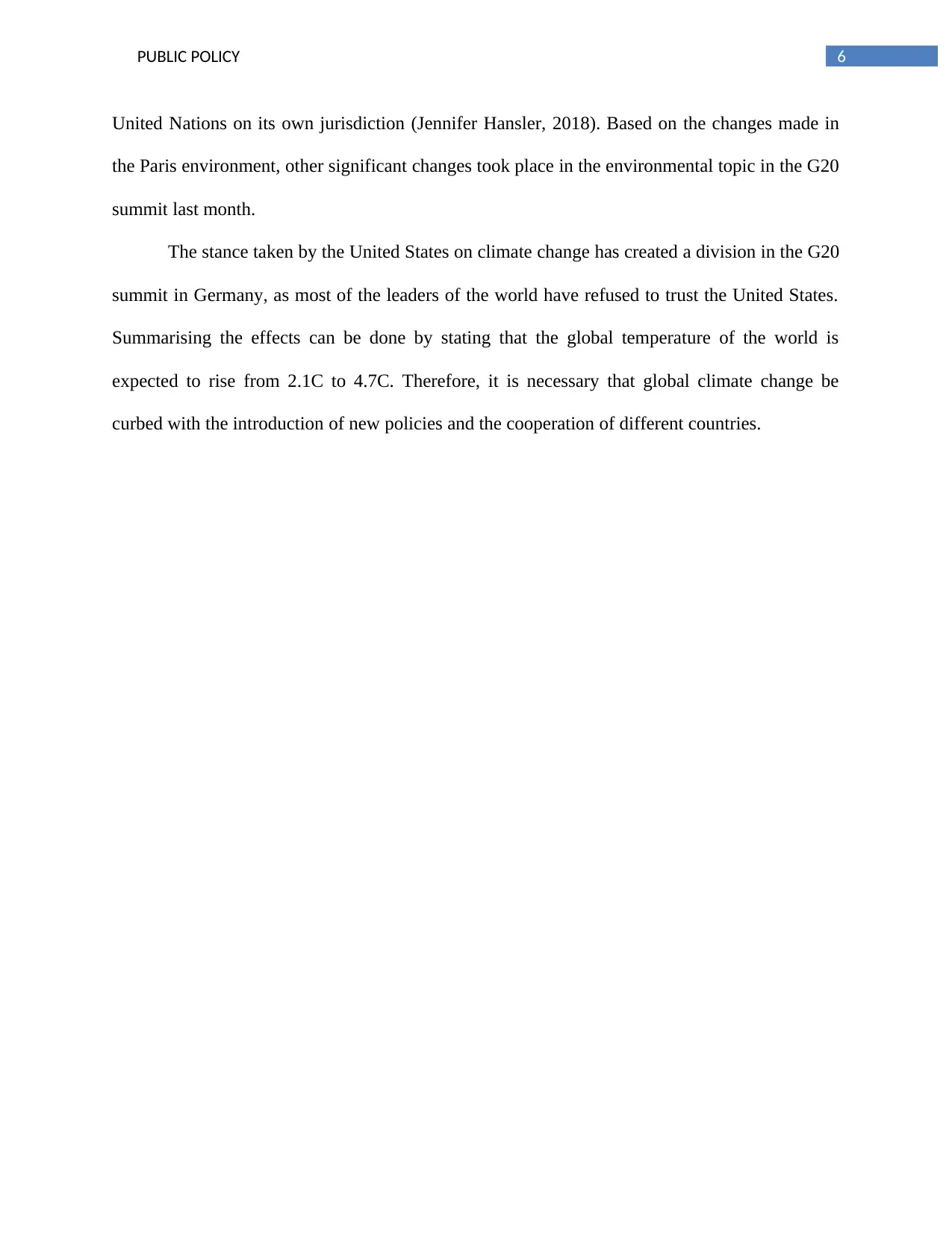
6PUBLIC POLICY
United Nations on its own jurisdiction (Jennifer Hansler, 2018). Based on the changes made in
the Paris environment, other significant changes took place in the environmental topic in the G20
summit last month.
The stance taken by the United States on climate change has created a division in the G20
summit in Germany, as most of the leaders of the world have refused to trust the United States.
Summarising the effects can be done by stating that the global temperature of the world is
expected to rise from 2.1C to 4.7C. Therefore, it is necessary that global climate change be
curbed with the introduction of new policies and the cooperation of different countries.
United Nations on its own jurisdiction (Jennifer Hansler, 2018). Based on the changes made in
the Paris environment, other significant changes took place in the environmental topic in the G20
summit last month.
The stance taken by the United States on climate change has created a division in the G20
summit in Germany, as most of the leaders of the world have refused to trust the United States.
Summarising the effects can be done by stating that the global temperature of the world is
expected to rise from 2.1C to 4.7C. Therefore, it is necessary that global climate change be
curbed with the introduction of new policies and the cooperation of different countries.
Paraphrase This Document
Need a fresh take? Get an instant paraphrase of this document with our AI Paraphraser
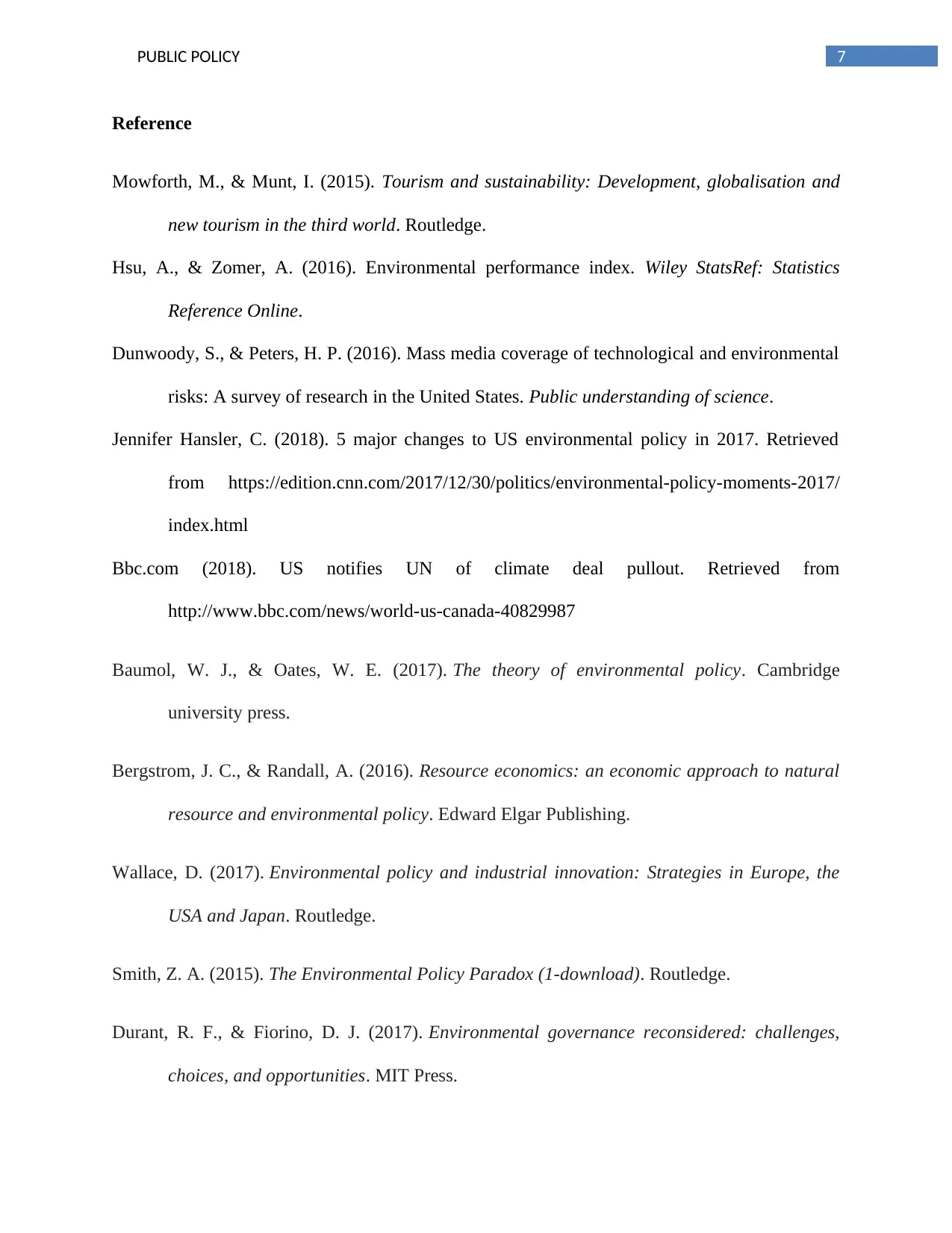
7PUBLIC POLICY
Reference
Mowforth, M., & Munt, I. (2015). Tourism and sustainability: Development, globalisation and
new tourism in the third world. Routledge.
Hsu, A., & Zomer, A. (2016). Environmental performance index. Wiley StatsRef: Statistics
Reference Online.
Dunwoody, S., & Peters, H. P. (2016). Mass media coverage of technological and environmental
risks: A survey of research in the United States. Public understanding of science.
Jennifer Hansler, C. (2018). 5 major changes to US environmental policy in 2017. Retrieved
from https://edition.cnn.com/2017/12/30/politics/environmental-policy-moments-2017/
index.html
Bbc.com (2018). US notifies UN of climate deal pullout. Retrieved from
http://www.bbc.com/news/world-us-canada-40829987
Baumol, W. J., & Oates, W. E. (2017). The theory of environmental policy. Cambridge
university press.
Bergstrom, J. C., & Randall, A. (2016). Resource economics: an economic approach to natural
resource and environmental policy. Edward Elgar Publishing.
Wallace, D. (2017). Environmental policy and industrial innovation: Strategies in Europe, the
USA and Japan. Routledge.
Smith, Z. A. (2015). The Environmental Policy Paradox (1-download). Routledge.
Durant, R. F., & Fiorino, D. J. (2017). Environmental governance reconsidered: challenges,
choices, and opportunities. MIT Press.
Reference
Mowforth, M., & Munt, I. (2015). Tourism and sustainability: Development, globalisation and
new tourism in the third world. Routledge.
Hsu, A., & Zomer, A. (2016). Environmental performance index. Wiley StatsRef: Statistics
Reference Online.
Dunwoody, S., & Peters, H. P. (2016). Mass media coverage of technological and environmental
risks: A survey of research in the United States. Public understanding of science.
Jennifer Hansler, C. (2018). 5 major changes to US environmental policy in 2017. Retrieved
from https://edition.cnn.com/2017/12/30/politics/environmental-policy-moments-2017/
index.html
Bbc.com (2018). US notifies UN of climate deal pullout. Retrieved from
http://www.bbc.com/news/world-us-canada-40829987
Baumol, W. J., & Oates, W. E. (2017). The theory of environmental policy. Cambridge
university press.
Bergstrom, J. C., & Randall, A. (2016). Resource economics: an economic approach to natural
resource and environmental policy. Edward Elgar Publishing.
Wallace, D. (2017). Environmental policy and industrial innovation: Strategies in Europe, the
USA and Japan. Routledge.
Smith, Z. A. (2015). The Environmental Policy Paradox (1-download). Routledge.
Durant, R. F., & Fiorino, D. J. (2017). Environmental governance reconsidered: challenges,
choices, and opportunities. MIT Press.
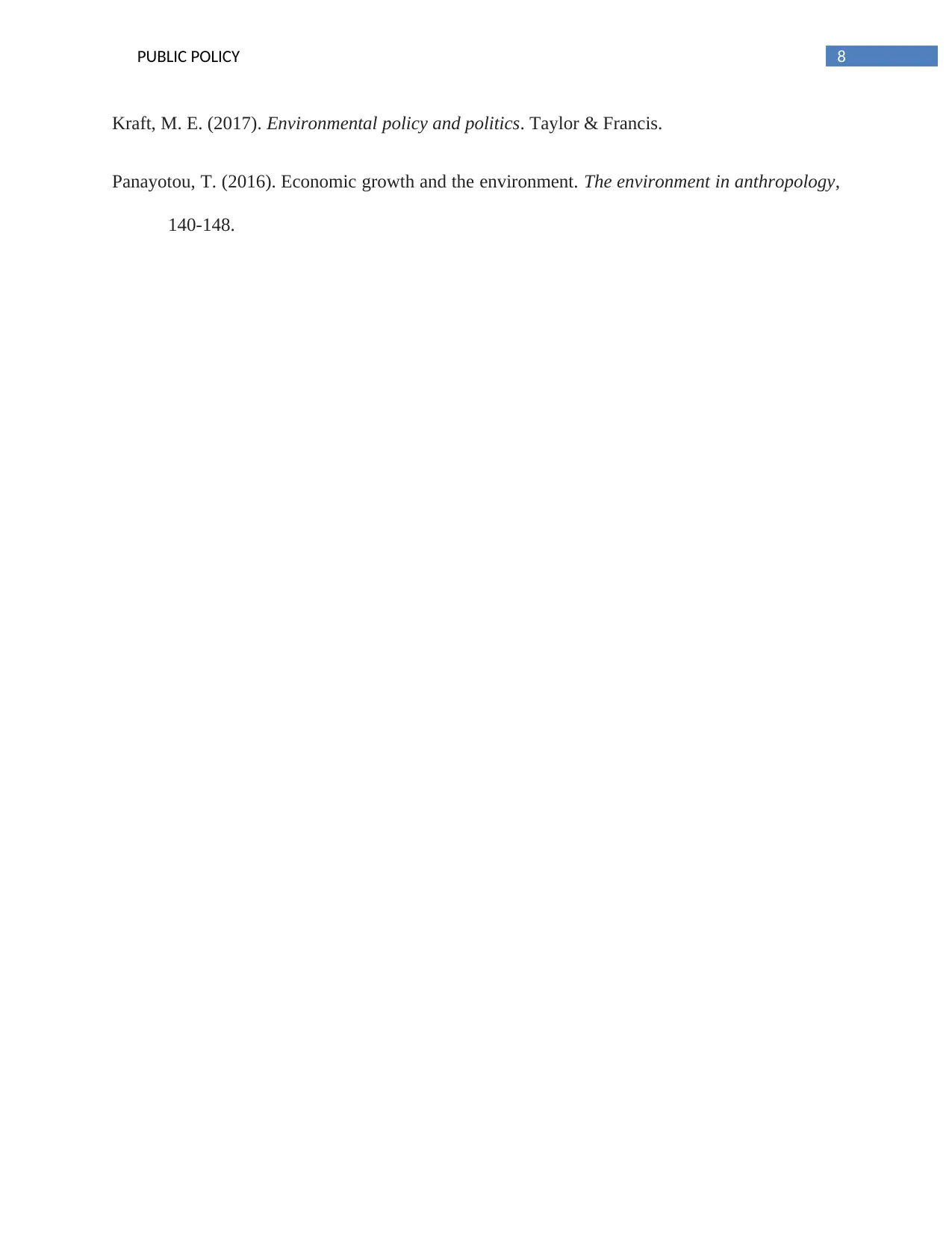
8PUBLIC POLICY
Kraft, M. E. (2017). Environmental policy and politics. Taylor & Francis.
Panayotou, T. (2016). Economic growth and the environment. The environment in anthropology,
140-148.
Kraft, M. E. (2017). Environmental policy and politics. Taylor & Francis.
Panayotou, T. (2016). Economic growth and the environment. The environment in anthropology,
140-148.
⊘ This is a preview!⊘
Do you want full access?
Subscribe today to unlock all pages.

Trusted by 1+ million students worldwide
1 out of 9
Related Documents
Your All-in-One AI-Powered Toolkit for Academic Success.
+13062052269
info@desklib.com
Available 24*7 on WhatsApp / Email
![[object Object]](/_next/static/media/star-bottom.7253800d.svg)
Unlock your academic potential
Copyright © 2020–2025 A2Z Services. All Rights Reserved. Developed and managed by ZUCOL.




